Concluso il Secondo Congresso Nazionale SWICo
Si è concluso presso la sede dell’Agenzia Spaziale Italiana il “Secondo Congresso Nazionale SWICo”. L’incontro si è svolto il 9, 10 e 11 febbraio 2022 (https://swico2021.web.roma2.infn.it/) ed è stato un momento di incontro e confronto dell’intera comunità elio-geofisica italiana impegnata nelle discipline relative allo Space Weather (dal Sole all’interno della Terra).
Durante il convegno si è tenuta l’Assemblea Nazionale SWICo per il rinnovo degli Organi Statutari ed è stato conferito il Premio “Franco Mariani” (https://swico2021.web.roma2.infn.it/premio-mariani), istituito per onorare la memoria di una personalità scientifica di statura internazionale e rivolto a giovani laureati magistrali in discipline inerenti lo “Space Weather”. Per ulteriore informazioni sul congresso SWICo raccomandiamo la lettura delle interviste uscite nei giorni scorsi:
Current state and perspectives of Space Weather science in Italy
Papers from SWICo members
Plainaki Christina, Antonucci Marco, Bemporad Alessandro, Berrilli Francesco, Bertucci Bruna, Castronuovo Marco, De Michelis Paola, Giardino Marco, Iuppa Roberto, Laurenza Monica, Marcucci Federica, Messerotti Mauro, Narici Livio, Negri Barbara, Nozzoli Francesco, Orsini Stefano, Romano Vincenzo, Cavallini Enrico, Polenta Gianluca, Ippolito Alessandro
This paper presents a brief state-of-the-art in Space Weather science in Italy and discuss some ideas on a long-term plan for the support of future scientific research in the related disciplines. Italian teams contributed in the advancing of our knowledge on the properties and evolution of the Space Weather phenomena with observational campaigns from space and from the ground. Numerous Space Weather forecasting and now-casting modeling efforts have resulted in a remarkable add-on to the overall progress in the field, at both national and international level. The Italian Space Agency participated several times in space missions related to Space Weather; indeed, the development of new instrumentation for future Heliophysics and Space Weather space missions will be very important for the Italian scientific and industrial communities.
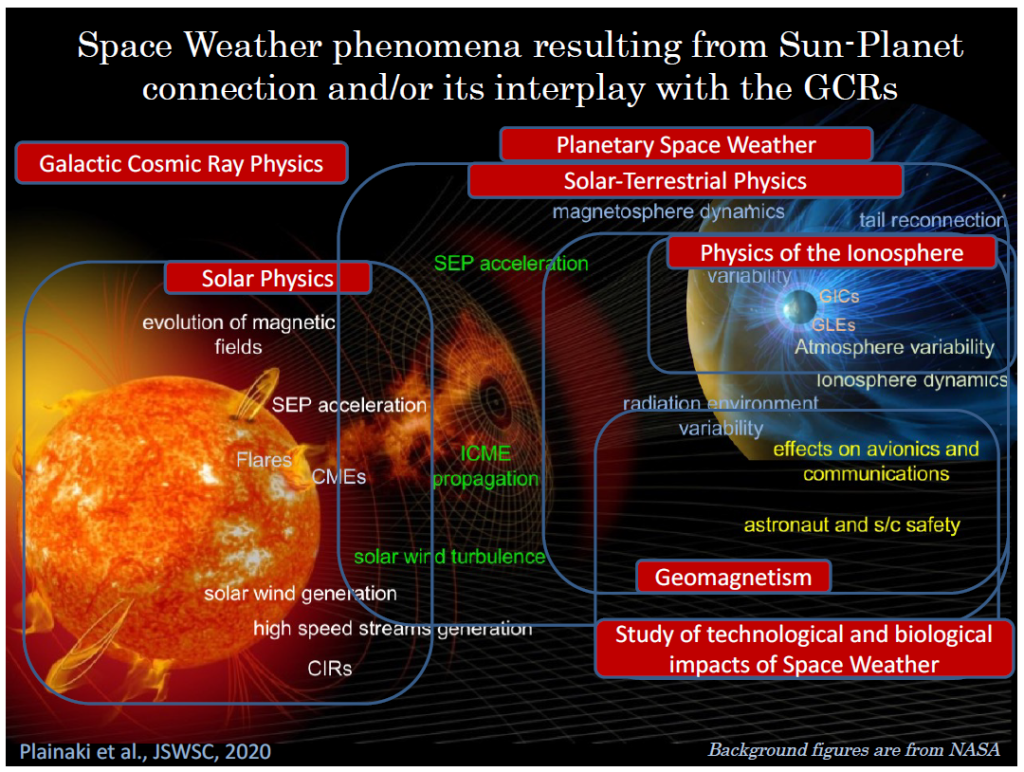
The Italian Space Agency aims to assess the possibility to develop a national scientific Space Weather data centre to encourage synergies between different science teams with interest in the field and to motivate innovation and new mission concept development. Alongside with the proposed recommendations, this paper also discusses how the Italian expertise could complement international efforts in a wider international Space Weather context.
Publication: Plainaki C., Antonucci M., Bemporad A., Berrilli F., Bertucci B., Castronuovo M., De Michelis P., et al., 2020, JSWSC, 10, 6. doi:10.1051/swsc/2020003. https://www.swsc-journal.org/articles/swsc/abs/2020/01/swsc190014/swsc190014.html
Can an impulsive variation of the solar wind plasma pressure trigger a plasma bubble? A case study based on CSES, Swarm and THEMIS data
Papers from SWICo members
M. Piersanti, M. Pezzopane, Z. Zhima, P. Diego, C. Xiong, R. Tozzi, A. Pignalberi, G. D’Angelo, R. Battiston, J. Huang, P. Picozza, Y. Rui, X. Shen, R. Sparvoli, P. Ubertini, Y. Yang, S. Zoffoli
During the August 25, 2018 geomagnetic storm, the new borne CSES-01 satellite and the Swarm A satellite detected a really large equatorial plasma bubble (EPB) in the post-midnight sector over western Africa. We investigated the features of this deep ionospheric plasma depletion using data from the Langmuir probes on-board CSES-01 and Swarm A satellites, and data from the high-precision magnetometer and the electric field detector instruments on-board CSES-01. Using also plasma and magnetic field data from THEMIS-E satellite we found that, during the passage of the magnetic cloud that drove the geomagnetic storm, an impulsive variation lasting about ten minutes characterized the solar wind (SW) pressure.
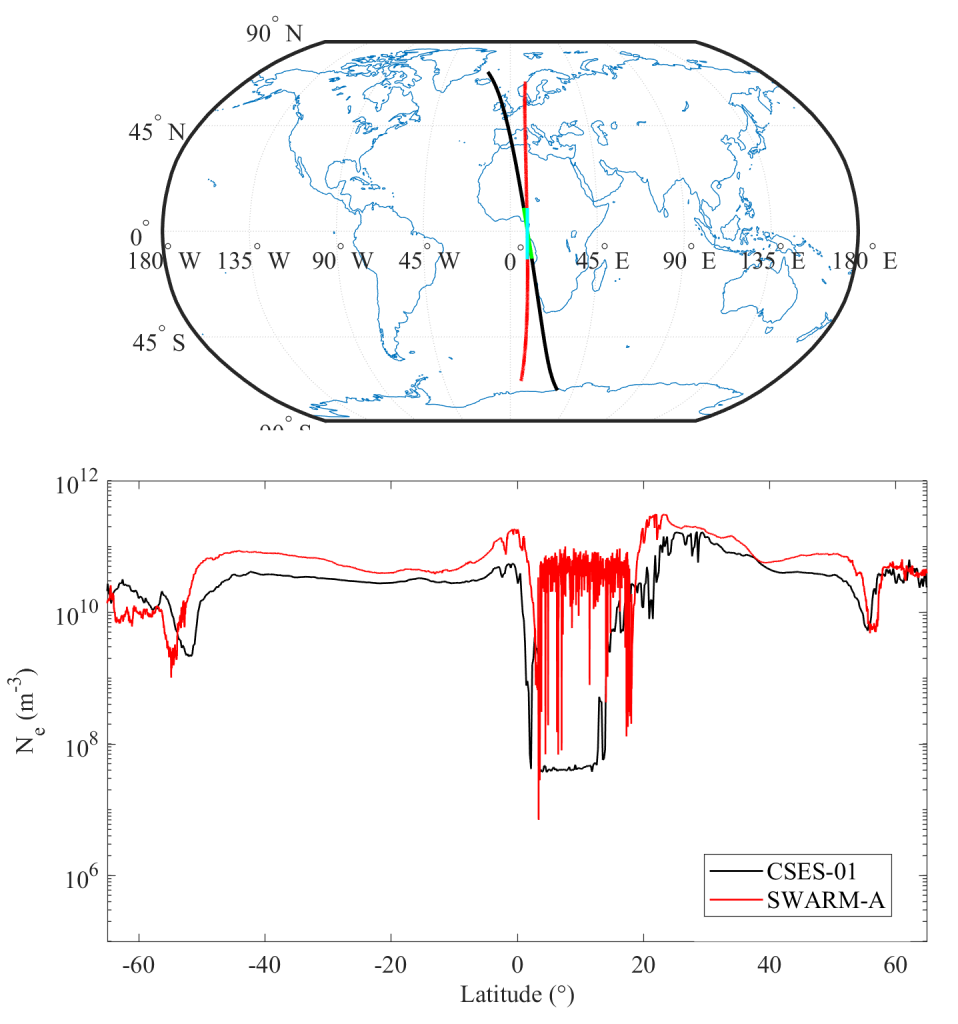
The analysis of the delay time, between the occurrence of such impulsive variation and the detection of the plasma bubble, suggests a possible link between the SW pressure impulsive variation as identified by THEMIS-E and the generation of the EPB as detected by CSES-01 and Swarm A. We put forward the hypothesis that the SW pressure impulsive variation might have triggered an eastward prompt penetrating electric field that propagated from high to equatorial latitudes, overlapping in the nightside region to the zonal westward electric field, causing either a reduction or an inversion, at the base of the EPB triggering.
Publication: M. Piersanti, M. Pezzopane, Z. Zhima et al., Can an impulsive variation of the solar wind plasma pressure trigger a plasma bubble? A case study based on CSES, Swarm and THEMIS data, Advances in Space Research 67, 35–45, 2021. https://doi.org/10.1016/j.asr.2020.07.046
The Great Aurora of 4 February 1872 observed by Angelo Secchi in Rome
Papers from SWICo members
Francesco Berrilli, Luca Giovannelli
On February 4, 1872, exactly 150 years ago, a great aurora was observed over a vast extent of the Earth. The aurora was also observed in Rome. In a pioneering work by Angelo Secchi, then director of the Observatory of the Roman College, there is the description of the multi-instrument observations carried out in Rome. An avant-garde work that describes what today we call an extreme event of Space Weather, an event with consequences on technological infrastructures on a planetary scale.
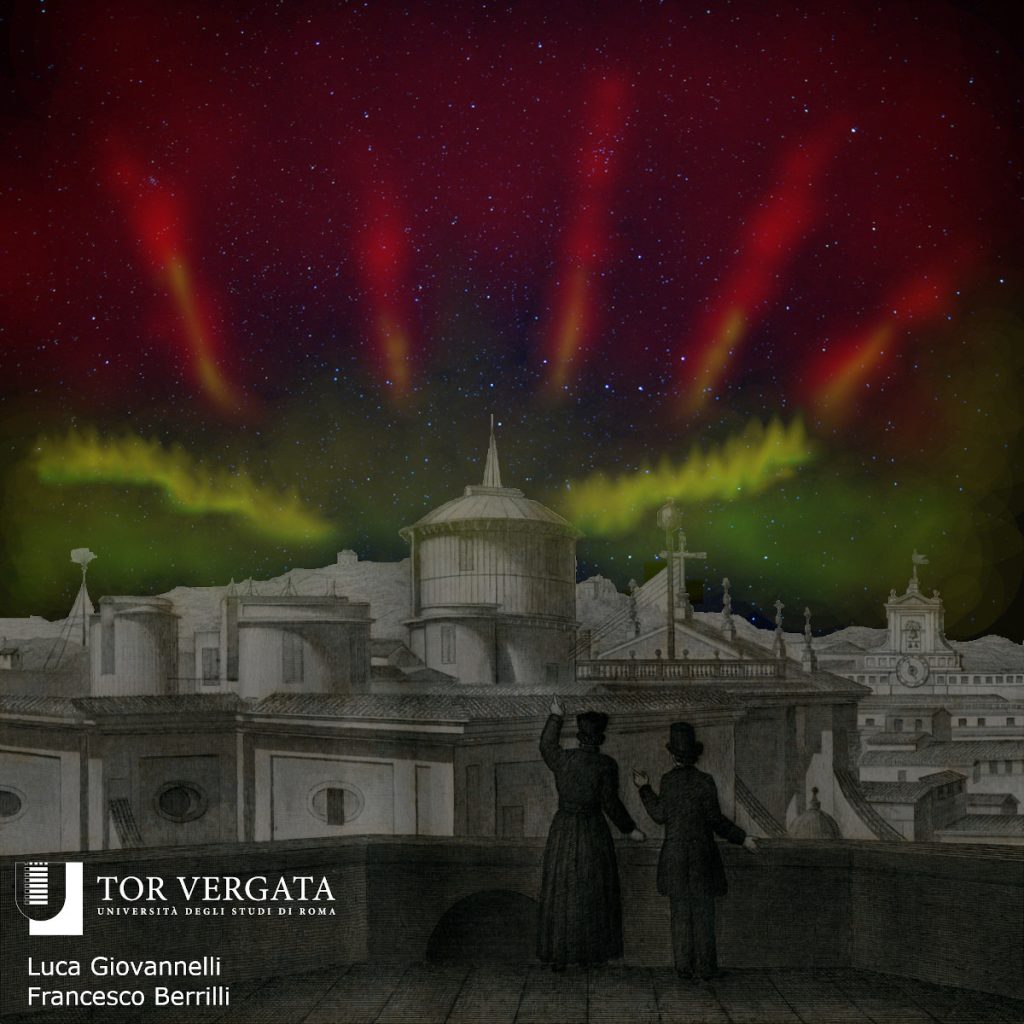
In a recent paper, we describe the main results of the observations and studies carried out by Angelo Secchi at the Observatory of the Roman College and described in his “Memoria sull’Aurora Elettrica del 4 Febbraio 1872” for the Notes of the Pontifical Academy of new Lincei.
Publication: Berrilli F., Giovannelli L., 2021, Journal of Space Weather and Space Climate, vol. 12. https://www.swsc-journal.org/articles/swsc/full_html/2022/01/swsc210083/swsc210083.html
Flare-forecasting Algorithms Based on High-gradient Polarity Inversion Lines in Active Regions
Papers from SWICo members
Domenico Cicogna, Francesco Berrilli, Daniele Calchetti, Dario Del Moro, Luca Giovannelli, Federico Benvenuto, Cristina Campi, Sabrina Guastavino, Michele Piana
Solar flares emanate from solar active regions hosting complex and strong bipolar magnetic fluxes. Estimating the probability of an active region to flare and defining reliable precursors of intense flares are extremely challenging tasks in the space weather field. In this work, we focus on two metrics as flare precursors, the unsigned flux R, tested on Michelson Doppler Imager/Solar and Heliospheric Observatory data, one of the most used parameters for flare-forecasting applications, and a novel topological parameter D, representing the complexity of a solar active region.
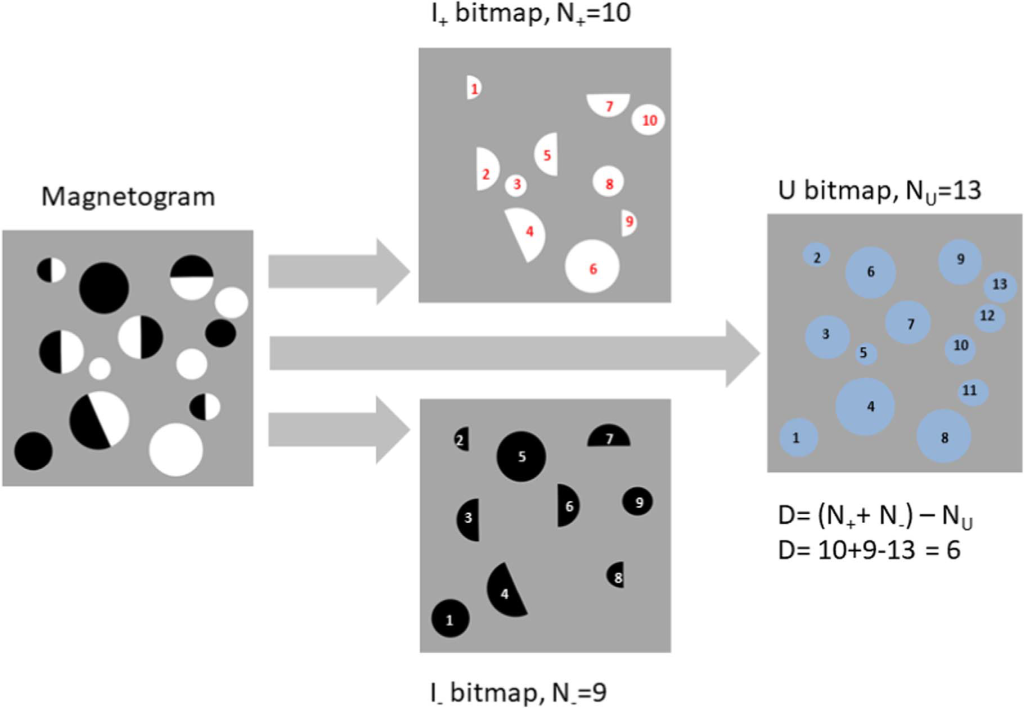
We use both a heuristic approach and a supervised machine-learning method to validate the effectiveness of these two descriptors to predict the occurrence of X- or M-class flares in a given solar active region during the following 24 hr period. Our feature ranking analysis shows that both parameters play a significant role in prediction performances. Moreover, the analysis demonstrates that the new topological parameter D is the only one, among 173 overall predictors, that is always present for all test subsets and is systematically ranked within the top 10 positions in all tests concerning the computation of the weights with which each predictor impacts the flare forecasting.
Publication: Cicogna D., Berrilli F., Calchetti D., Del Moro D., Giovannelli L., Benvenuto F., Campi C., et al., 2021, ApJ, 915, 38. doi:10.3847/1538-4357/abfafb. https://iopscience.iop.org/article/10.3847/1538-4357/abfafb
Data reduction pipeline for MOF-based synoptic telescopes
Papers from SWICo members
Roberta Forte, Francesco Berrilli, Daniele Calchetti, Dario Del Moro, Bernhard Fleck, Cynthia Giebink, William Giebink, Luca Giovannelli, Stuart Mark Jefferies, Allister Knox, Maria Magrì, Neil Murphy, Garry Nitta, Maurizio Oliviero, Ermanno Pietropaolo, Wayne Rodgers, Stefano Scardigli, Giorgio Viavattene
The synoptic telescopes based on Magneto Optical Filters (MOF) using different lines are capable of measuring the line-of-sight Doppler velocity and magnetic field over the full solar disk at different ranges of height in the Sun’s photosphere and low chromosphere. Instruments like the MOTH (Magneto-Optical filters at Two Heights), using a dual-channel based on MOFs operating at 589.0 nm (Na D2 line) and 769.9 nm (K D1 line), the VAMOS instrument (Velocity And Magnetic Observations of the Sun), operating at 769.9 nm (K D1 line), and the future TSST (Tor Vergata Synoptic Solar Telescope), using a dual-channel telescope operating at 656.28 nm (H-alpha line) and at 769.9 nm (K D1 line), allow to face both aspects, the scientific and the operative related to Space Weather applications.
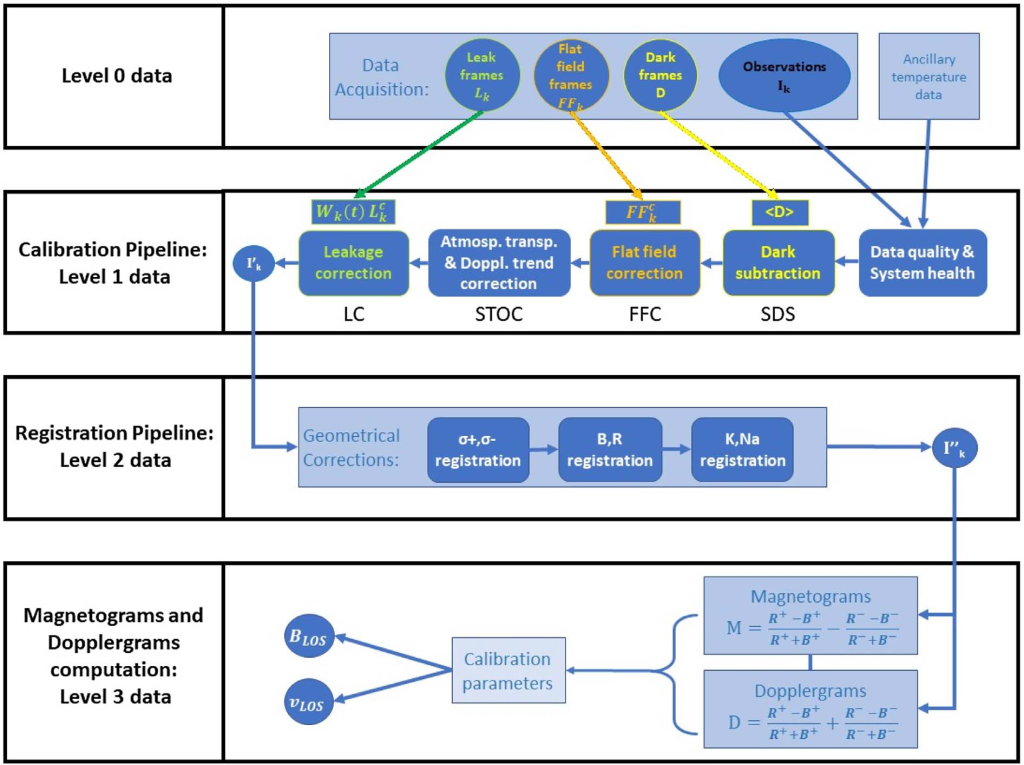
The MOTH, VAMOS and TSST data enable a wide variety of studies of the Sun, from seismic probing of the solar interior (sound speed, rotation, details of the tachocline, sub-surface structure of active regions), to the dynamics and magnetic evolution of the lower part of the solar atmosphere (heating of the solar atmosphere, identification of the signatures of solar eruptive events, atmospheric gravity waves, etc.), to the 3D reconstruction of the solar atmosphere and flare locations. However, the use of MOF filters requires special care in calibrating the data for scientific or operational use. This work presents a systematic pipeline that derives from the decennial use of MOF’s technology. More in detail, the pipeline is based on data reduction procedures tested and validated on MOTH data acquired at Mees Solar Observatory of the University of Hawaii Haleakala Observatories and at South Pole Solar Observatory (SPSO), at the Amundsen-Scott South Pole Station in Antarctica, during Antarctica Summer Campaign 2016/17.
Publication: Forte R., Berrilli F., Calchetti D., Del Moro D., Fleck B., Giebink C., Giebink W., et al., 2020, JSWSC, 10, 63. doi:10.1051/swsc/2020065. https://www.swsc-journal.org/articles/swsc/full_html/2020/01/swsc200064/swsc200064.html
The Tor Vergata Synoptic Solar Telescope (TSST): A robotic, compact facility for solar full disk imaging
Papers from SWICo members
Luca Giovannelli, Francesco Berrilli, Daniele Calchetti, Dario Del Moro, Giorgio Viavattene, Ermanno Pietropaolo, Marco Iarlori, Vincenzo Rizi, Stuart Mark Jefferies, Maurizio Oliviero, Luciano Terranegra, Neil Murphy
By the continuous multi-line observation of the solar atmosphere, it is possible to infer the magnetic and dynamical status of the Sun. This activity is essential to identify the possible precursors of space weather events, such as flare or coronal mass ejections. We describe the design and assembly of TSST (Tor Vergata Synoptic Solar Telescope), a robotic synoptic telescope currently composed of two main full-disk instruments, a Hα telescope and a Potassium (KI D1) magneto-optical filter (MOF)-based telescope operating at 769.9 nm.
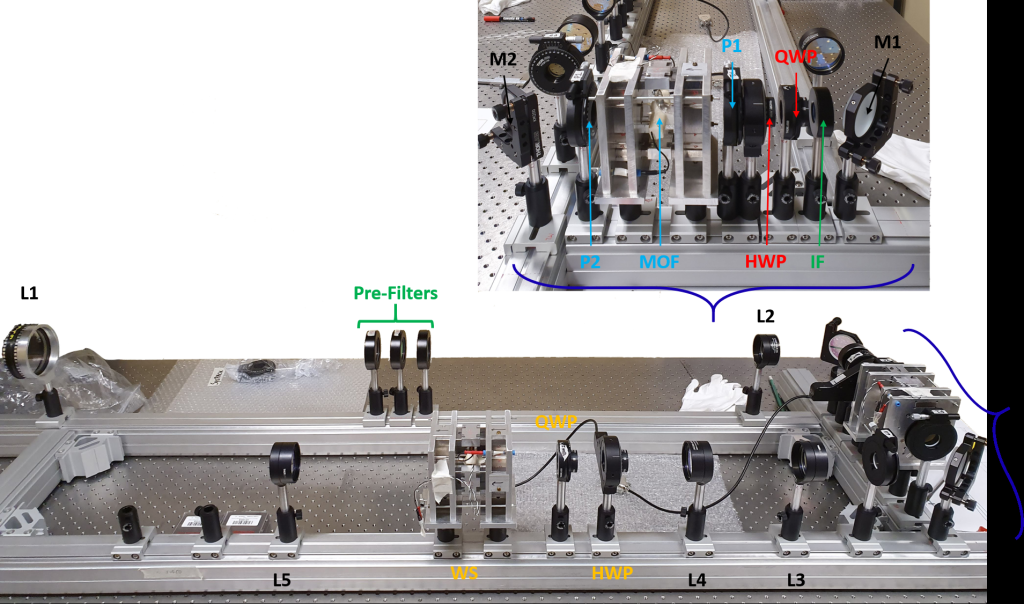
TSST is designed to be later upgraded with a second MOF channel. This paper describes the TSST concepts and presents the first light observation carried out in February 2020. We show that TSST is a low-cost robotic facility able to achieve the necessary data for the study of precursors of space weather events (using the magnetic and velocity maps by the MOF telescope) and fast flare detection (by the Hα telescope) to support Space Weather investigation and services.
Publications: Giovannelli L., Berrilli F., Calchetti D., Del Moro D., Viavattene G., Pietropaolo E., Iarlori M., et al., 2020, JSWSC, 10, 58. doi:10.1051/swsc/2020061. https://www.swsc-journal.org/articles/swsc/full_html/2020/01/swsc200063/swsc200063.html
Daniele Calchetti, Giorgio Viavattene, Luciano Terranegra, Ermanno Pietropaolo, Maurizio Oliviero, Neil Murphy, Start M. Jefferies, Luca Giovannelli, Dario Del Moro, and Francesco Berrilli, Proc. SPIE 11445, Ground-based and Airborne Telescopes VIII, 114452T (13 December 2020); https://doi.org/10.1117/12.2562454
Calchetti D, Viavattene G, Berrilli F, Del Moro D, Giovannelli L, Oliviero M. 2020. Journal of Physics Conference Series, Vol. 1548. https://doi.org/10.1088/1742-6596/1548/1/012005
Viavattene G, Calchetti D, Berrilli F, Del Moro D, Giovannelli L, Pietropaolo E, Oliviero M, Terranegra L. 2020. Il Nuovo
Ciment C (Ed.), Vol. 43 of Il Nuovo Cimento C, 120 p. https://doi.org/10.1393/ncc/i2020-20120-6
On the link between the topside ionospheric effective scale height and the plasma ambipolar diffusion, theory and preliminary results
Papers from SWICo members
A. Pignalberi, M. Pezzopane, B. Nava, P. Coïsson
Over the years, an amount of models relying on effective parameters were implemented in the challenging issue of the topside ionosphere description. These models are based on different analytical functions, but all of them depend on a parameter called effective scale height, that is deduced from topside electron density measurements. As their names state, they are effective in reproducing the topside electron density profile only when applied to the analytical function used to derive them. Then, in principle, they do not have any physical meaning. It is the goal of this paper to mathematically link the effective scale height modeled through the Epstein layer to the vertical scale height theoretically deduced from the plasma ambipolar diffusion theory.
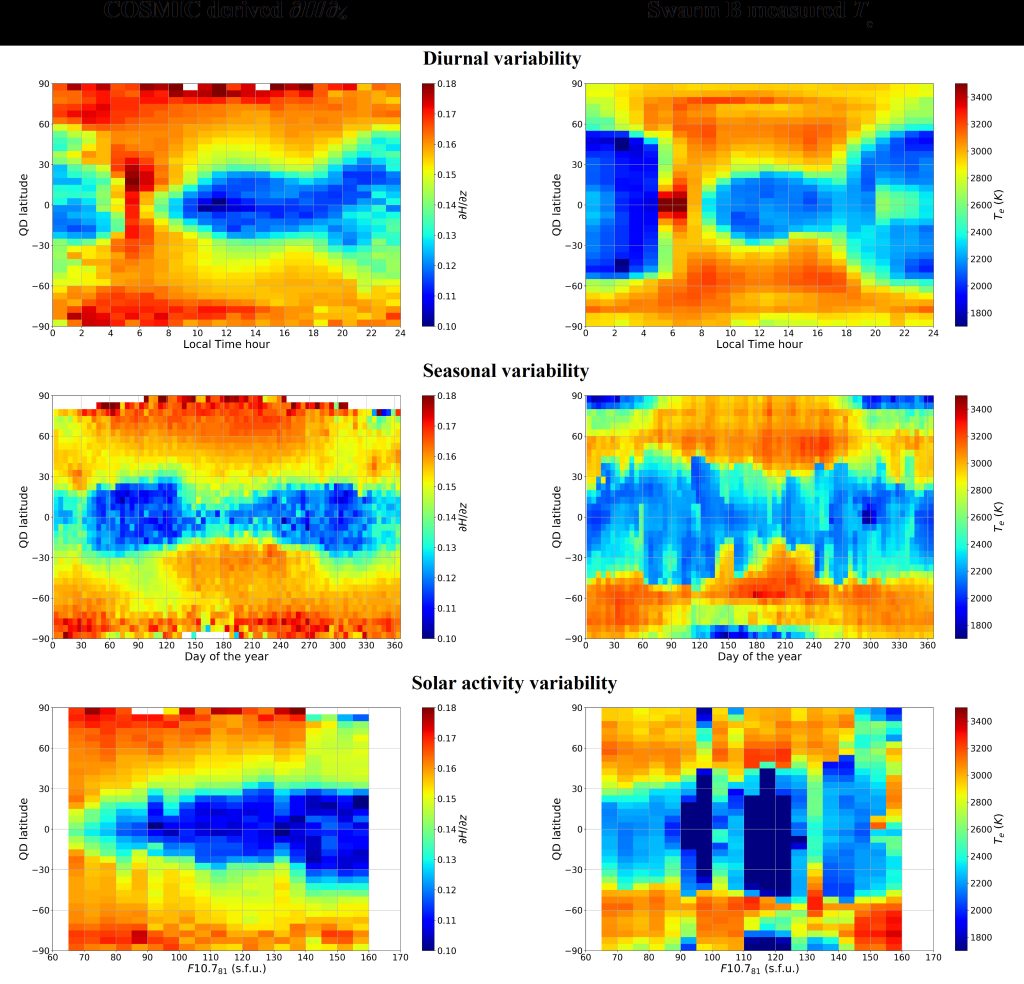
Firstly, effective and theoretical scale heights are linked through a mathematical relation by showing that they tend to each other in the topside ionosphere. Secondly, their connection is preliminarily demonstrated by calculating effective scale height values from the entire COSMIC/FORMOSAT-3 radio occultation dataset. Thirdly, a possible connection between the vertical gradient of the topside scale height (as obtained by COSMIC/FORMOSAT-3 satellites) and the electron temperature (as obtained by ESA Swarm B satellite) is studied by highlighting corresponding similarities in the diurnal, seasonal, solar activity, and latitudinal variability.
Publication: A. Pignalberi, M. Pezzopane, B. Nava, P. Coïsson, On the link between the topside ionospheric effective scale height and the plasma ambipolar diffusion, theory and preliminary results, Scientific Reports 10:17541, 2020. https://doi.org/10.1038/s41598-020-73886-4
Hints on the Multiscale Nature of Geomagnetic Field Fluctuations During Quiet and Disturbed Periods
Papers from SWICo members
L. Santarelli, P. De Michelis, G. Consolini
We analyse the short timescale fluctuations (τ < 200 min) of the magnetic signals recorded at 78 ground stations from 13 to 31 March 2015, focusing our attention on sources which are external to the Earth, that is, due to current systems flowing in the ionosphere and magnetosphere, and investigating their dependence on magnetic latitude, magnetic local time, and geomagnetic activity. We find that, at geomagnetic latitudes >|60°|, such fluctuations constitute more than 30% of the external magnetic field, and their maximum contribution occurs along the auroral oval suggesting that they are mainly triggered by the ionospheric electric current systems active in these regions.

These short timescale magnetic fluctuations are very relevant in contributing to the prediction of geomagnetically induced currents in the auroral zones.
Publication: L. Santarelli, P. De Michelis, G. Consolini, Hints of the Multiscale Nature of Geomagnetic Field Fluctuations during Quiet and Disturbed Periods, J. Geophys. Res.: Space Physics, 126 (5), 2021. https://doi.org/10.1029/2020JA028596
Ionospheric Turbulence and the Equatorial Plasma Density Irregularities: Scaling Features and RODI
Papers from SWICo members
P. De Michelis, G. Consolini, R. Tozzi, A. Pignalberi, M. Pezzopane, I. Coco, F. Giannattasio, and M.F. Marcucci
Equatorial plasma bubbles are ionospheric irregularities that usually occur after sunset and are characterized by strong density depletions. At the edges and inside the bubbles plasma turbulence processes are thought to take place, that are able to perturb electromagnetic signals crossing these regions, such as for example those from GNSS satellites. We investigated the relationship between the Rate Of change of electron Density Index (RODI) and the scaling features of the electron density during plasma bubbles crossings, as identified by 22 months of data of the Swarm A spacecraft (2014-2016).
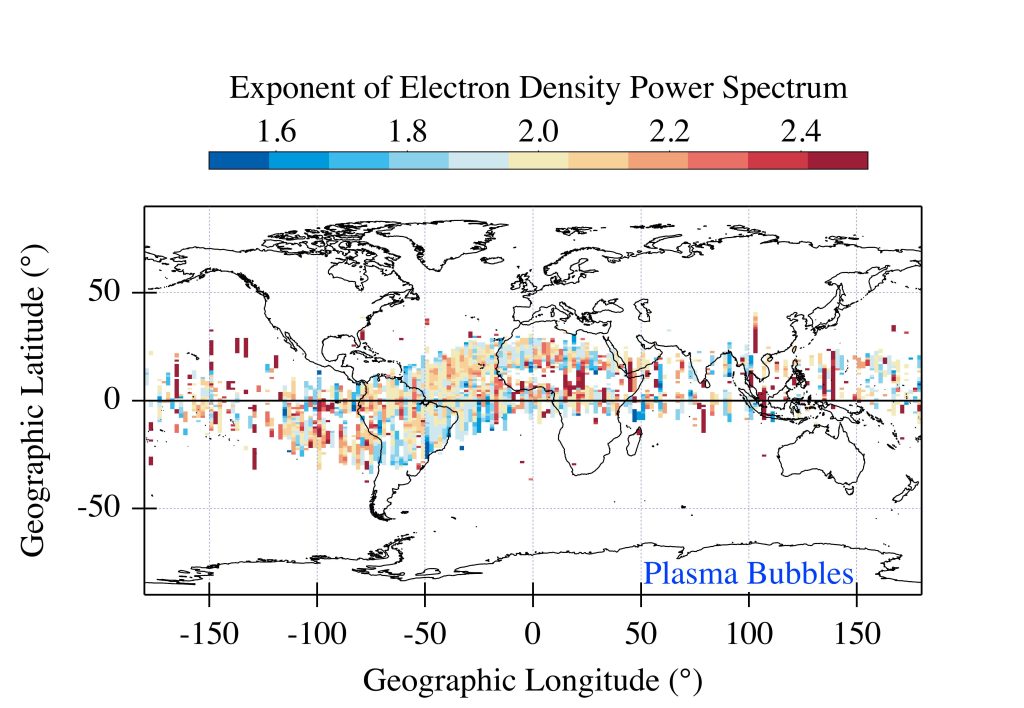
We found that plasma bubbles exhibit scaling properties, which are completely different from the surrounding environment and are associated with large density gradients. These large density gradients, which are certainly the result of the turbulent nature of the irregularities, are reflected in high RODI values. Therefore, RODI could be used as a proxy of those ionospheric irregularities which are characterized by a turbulent nature.
Publication: P.De Michelis, G. Consolini, R. Tozzi, A. Pignalberi, M. Pezzopane, I. Coco, F. Giannattasio, M. F. Marcucci, Ionospheric Turbulence and the Equatorial Plasma Density Irregularities: Scaling Features and RODI, Remote Sens., 13, 759, 2021. https://doi.org/10.3390/rs13040759
